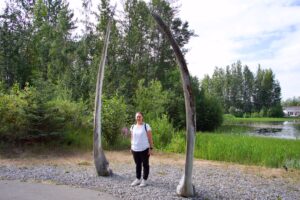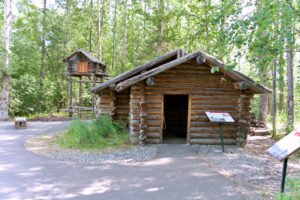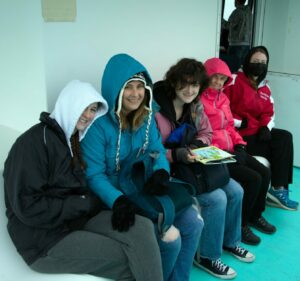
Entrance to the Alaska Native Heritage Center
Our Alaska adventure ended back where we started in Anchorage. We had come full circle, and to conclude our explorations we visited the Alaska Native Heritage Center to learn more about the Indigenous groups that live in Alaska.
The Alaska Native Heritage Center is a wealth of information and history, but also a place to witness vibrant Indigenous culture thriving today. There are five distinct Indigenous groups in Alaska: Yup’ik/Cup’ik, Iñupiaq/St. Lawrence Island Yup’ik, Athabascan, Alutiiq (Sugpiak), and Eyak/Haida/Tsimshian/Tlingit. Each group has a unique cultural identity created by location and available resources. Iditarod runs through the center of Alaska and Athabascan land, to the coast where Yup’ik and Inupiak lands meet. Understanding more about these cultures, communities, and their contributions is essential to fully realize the complex and challenging history of Alaska.
The Center has multiple ways to engage visitors including exhibits, films, demonstrations, and guided tours. Throughout each of these experiences I discovered a particularly impactful common thread – Native living and learning is a multi-generational experience.
- The regional resources available influence Native life in Alaska
- Learning about Indigenous cultures at the Alaska Native Heritage Center. Check out these incredible whalebone markers! Photo Credit: J.Westrich
- Totem pole created for the Alaska Native Heritage Center
- Traditional kayak
Throughout the tour of the Village Sites we heard time and again about the importance of Elders in the community, the need for children to learn from those with more experience, and to hear the stories that will guide them to adulthood. Storytelling, especially for groups without a written language, is an essential tool to share culture, history, and knowledge. Respect for those who hold the knowledge is extremely important. Elders teach the skills essential for survival and share the stories of community.
- Traditional Athabascan winter home
- Yu’pik/Cu’pik Village site
- Traditional home of the Eyat, Haida, Tsimshin, Tlingit
Taking up this thread, it was easy to see how this is put into practice at the Alaska Native Heritage Center. Within the Hall of Cultures, Alaska Native artists display and sell their work. Here we met the friendliest people, willing to share their stories with us, explain their artwork, and make meaningful connections. A painter, who has been with the Heritage Center since its opening in 1999, told us about his long history sharing his craft with visitors. Each vendor was generous with their time and knowledge. This was evident when my daughter, a knitter, met a woman knitting with Musk Ox fiber. Fascinated, she asked lots questions which were kindly and patiently answered. My daughter then circled around and pulled my mother-in-law, also a knitter, to the table. Here I witnessed the sharing of knowledge across cultures and between generations.

Alaska Native Heritage Center Dance Performance
In contrast to the Native artists, the docents and demonstrators at the Heritage Center were all visibly young – at least to me. I’d guess nearly all of them were under 25, many still teens. They demonstrated traditional games, imparted knowledge as tour guides, answered questions, and presented dance and music performances. Passion and pride was evident in the younger generation. It is now their turn to continue traditions, and educate about the important contributions of Alaska Native cultures.
Our vacation included three generations of travelers, which can sometimes make things challenging. However, the benefits of learning, sharing, and travelling together far outweighed any issues. As we watched the elders at the Heritage Center share their wisdom through craft, and then saw the younger generation share with us their history, dance, games, and stories, I was so grateful: grateful to have seen the cultural contributions of the Indigenous people of Alaska, grateful to have done so with the generations above and below me, grateful to have shared the experience together.
- Three generations explore Alaska
- Display in the Hall of Cultures highlighting the Inupiaq cultural emphasis on learning from Elders
- Grandmother and granddaughter wrapping up their Alaskan adventure together
Library Learnings: How do your students learn from their elders? Classrooms are filled with students with diverse family relationships. Some students live far away from grandparents and only see them sporadically at holidays or special events. Others live in a multi-generational household, immersed in a family culture very different from their school culture. Validate students’ family culture by sharing stories that promote multi-generational learning experiences and invite students to share their own stories. I suggest Amy Wu and the Perfect Bao by Kat Zhang, Going Down Home with Daddy by Kelly Starling Lyons, Ohana Means Family by Ilima Loomis, or The Proudest Blue by Ibtihaj Muhammad to get the conversation started.












